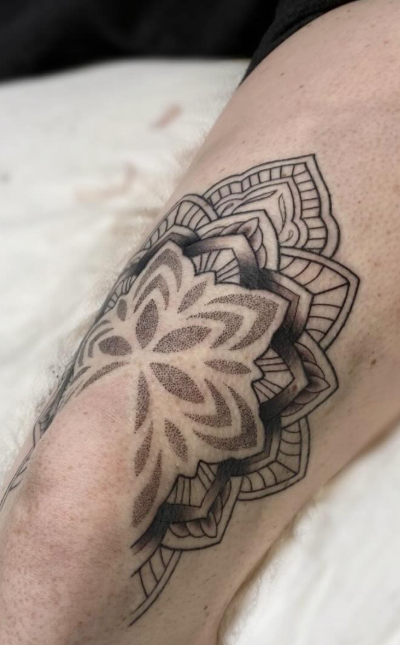
The Cultural Significance of Mandala Tattoos
Mandala tattoos are more than just beautiful designs; they carry deep cultural and spiritual significance. Rooted in ancient traditions, mandalas symbolize unity, balance, and harmony. These intricate geometric patterns have been used in various cultures for centuries, serving as spiritual symbols and tools for meditation.
Historical and Cultural Origins
Mandalas originate from ancient Indian and Tibetan cultures, where they were used in spiritual practices and rituals. The word “mandala” comes from Sanskrit, meaning “circle” or “center.” In Hinduism and Buddhism, mandalas represent the universe and the cycle of life, death, and rebirth.
In Hindu culture, practitioners use mandalas in rituals to create sacred spaces. For example, during ceremonies, they draw mandalas to invoke the divine’s presence and protect participants. Similarly, in Buddhism, monks use mandalas for meditation and spiritual growth. They create intricate sand mandalas to represent life’s impermanence and then destroy them to symbolize the transient nature of existence.
Symbolism in Mandala Tattoos
Mandala tattoos carry rich symbolism, making them popular among those seeking meaningful body art. Each element within a mandala has a specific meaning, contributing to the overall significance of the design.
For instance:
- Circles: Represent wholeness, unity, and the cycle of life.
- Squares: Symbolize stability and order.
- Triangles: Indicate direction and change, with upward triangles representing action and downward triangles symbolizing passive energy.
- Lotus Petals: Signify purity and spiritual awakening.
- Radial Balance: The symmetrical and balanced nature of mandalas represents harmony and equilibrium.
Modern Interpretations
Today, people appreciate mandala tattoos for their aesthetic beauty and profound meanings. Many individuals choose mandala tattoos to reflect their spiritual beliefs, personal growth, and desire for balance. Additionally, the process of designing and getting a mandala tattoo can be meditative, allowing individuals to connect with their inner selves.
Moreover, mandala tattoos have evolved to incorporate modern elements, blending traditional symbolism with contemporary styles. Artists experiment with different shapes, colors, and patterns, creating unique and personalized designs that resonate with the wearer’s individuality.
Mandala tattoos offer a testament to the enduring appeal of ancient symbols and their ability to adapt to modern interpretations. They provide individuals a way to express their spirituality, seek balance, and connect with their cultural heritage. Whether chosen for their beauty or their deep meanings, mandala tattoos continue to inspire and captivate people around the world.
